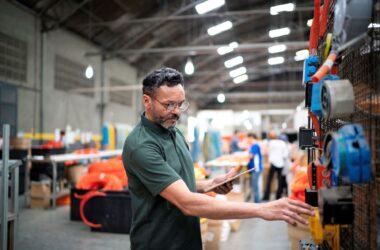Addressing Scope 3 Emissions in Construction: Unlocking Greater Value
Scope 3 emissions are a pressing topic for the construction industry, yet they remain one of the most challenging areas to address effectively.
Companies that tackle Scope 3 emissions proactively can position themselves as leaders in sustainability, attracting eco-conscious clients, investors, and partners.

Addressing Scope 3 emissions in the construction industry is an essential step towards sustainability and reducing the environmental impact of construction projects.
The construction industry has long stood as an emblem of progress, crafting the cities and structures that shape our modern world. However, this industry also casts a significant shadow on the environment, accounting for nearly 40% of global carbon emissions. Although attention has been directed towards reducing emissions from operational activities (Scope 1 and 2), the often-overlooked Scope 3 emissions present a colossal challenge demanding immediate action.
Construction needs to address Scope 3 emissions, which originate from sources beyond a company’s direct control but are linked to their activities. From the materials sourced to the transportation of goods, the industry’s footprint extends across the entire lifecycle of a project.
Understanding Scope 3 Emissions

When reporting on greenhouse gas emissions, organisations often divide emissions into three categories: Scope 1, 2, and 3.
Scope 1 emissions come from sources that an organisation owns or controls directly and include things like emissions that come from running boilers or driving vehicles.
Scope 2 emissions are indirectly made emissions, such as the energy used in a building.
What Are Scope 3 Emissions?
Scope 3 emissions cover emissions that an organisation is indirectly responsible for up and down its value chain. They are not produced by the organisation itself and they’re not the result of activities from assets owned or controlled by them.
Sources of Scope 3 Emissions in Construction
Scope 3 emissions in the construction industry originate from sources that are indirectly associated with a construction project but are essential components of its lifecycle. This can include:
- Materials production & transportation
- Supply chain
- Construction operations, e.g. equipment & machinery or onsite energy usage
- Transportation of workers & equipment
- End-of-life demolition & disposal
The Impact of Scope 3 Emissions in the Construction Industry
Scope 3 emissions in the construction industry have a significant and wide-ranging environmental impact, contributing to various environmental challenges and sustainability concerns. The environmental impacts of Scope 3 emissions in construction include:
- Greenhouse gas emissions
- Resource depletion
- Energy consumption
- Water use & pollution
- Air pollution
- Waste generation
- Habitat disruption
- Waste heat
Scope 3 emissions also have an economic and social impact, from cost and liability implications, to supply chain disruptions and health and wellbeing concerns.
Strategies for Addressing Scope 3 Emissions

By implementing a range of strategies that target emissions sources throughout the entire project lifecycle, the construction industry can begin to reduce Scope 3 emissions alongside its efforts to reduce Scope 1 and 2 emissions.
Sustainable Material Selection
Choosing construction materials with a lower carbon footprint is one way of addressing Scope 3 emissions. For example, opt for recycled, reclaimed, or locally sourced materials.
Supply Chain Management
A construction company’s supply chain presents multiple opportunities for optimisation. Collaborate with suppliers to identify emissions reduction opportunities and prioritise local suppliers to reduce transportation-related emissions.
Digital Solutions
Digital procurement solutions are an invaluable tool for addressing Scope 3 emissions. We created The Build Chain to support local supply chains and increase the efficiency of construction procurement.
Energy-efficient design and construction, alongside appropriate waste reduction and recycling processes are other ways construction companies can commit to reducing their Scope 3 emissions. Construction companies could also look at their transportation and logistics: for example, encouraging workers to car share, use public transport, or cycle to work.
Learn More: How To Align Construction Procurement With Sustainability Goals
Addressing Scope 3 emissions is a key step in reducing the carbon footprint of the construction industry. It requires a holistic approach that considers both the financial and societal aspects of construction projects. Sustainable construction practices that reduce emissions can contribute to economic growth, community well-being, and environmental stewardship.
By implementing strategies such as sustainable materials selection and supply chain optimisation, the construction industry can make significant progress in reducing Scope 3 emissions, contributing to a more sustainable and environmentally responsible construction industry.
Breaking Down Scope 3 Challenges
- Data Collection and Transparency
Gathering accurate emissions data across the supply chain is a significant challenge. Many suppliers and subcontractors lack robust reporting systems, making it difficult to track and verify emissions.Solution: Encourage partnerships with suppliers who adhere to sustainability certifications and standards, such as ISO 14001 or Environmental Product Declarations (EPDs). Digital tools like The Build Chain can simplify supplier assessments, ensuring greater transparency and alignment with sustainability goals. - Collaborative Accountability
Scope 3 emissions require collaboration across all tiers of the supply chain. Without collective accountability, progress stalls.Solution: Create clear contracts that mandate sustainability practices for subcontractors and suppliers. For example, include requirements for using lower-carbon materials or adhering to waste reduction strategies.
Leveraging Technology to Tackle Scope 3 Emissions
- AI-Driven Insights
Platforms like The Build Chain are incorporating AI to analyze supplier data, material choices, and transportation methods, helping companies identify high-emission areas and suggesting greener alternatives. - Real-Time Emissions Tracking
Digital tools can provide real-time monitoring of emissions from activities like transportation and onsite operations. This allows construction companies to adjust their strategies dynamically, reducing emissions more effectively. - Material Marketplace with Carbon Data
Imagine a procurement platform where every material comes with embedded carbon data. Contractors could compare suppliers based on environmental impact and cost, enabling smarter decision-making at the design stage.
Practical Steps to Start Reducing Scope 3 Emissions
- Choose Low-Carbon Materials
Opt for materials with lower embodied carbon, such as recycled steel, low-carbon concrete, and sustainably sourced timber. - Streamline Logistics
Reducing transportation distances and optimizing delivery schedules can significantly lower emissions from freight. Consolidate orders and work with suppliers who use electric or alternative fuel vehicles. - Educate and Engage the Supply Chain
Conduct workshops and training sessions to help suppliers and subcontractors understand the importance of Scope 3 emissions and how to mitigate them. - Align with Green Building Certifications
Target certifications like BREEAM or LEED, which emphasize sustainable practices, including Scope 3 emissions reduction, to showcase your commitment to sustainability.
The Future of Scope 3 Emissions in Construction

The pressure to address Scope 3 emissions is only increasing as governments, investors, and clients prioritize ESG goals. Tackling these emissions isn’t just about meeting targets—it’s about staying competitive in an industry undergoing rapid transformation.
By combining innovative technology, collaborative practices, and proactive strategies, the construction sector can lead the charge in building a greener future. Tools like The Build Chain empower companies to take meaningful steps toward reducing Scope 3 emissions within their projects, setting new standards for sustainability and efficiency.
Ready to Take Action?
The journey to reducing Scope 3 reporting when procuring your materials for site and saving emissions begins with small, actionable steps. Discover how The Build Chain can support your sustainability goals and simplify the complexities of managing your supply chain.

The Build Chain is helping SME Contractors & Housebuilders procure materials and equipment more sustainability




